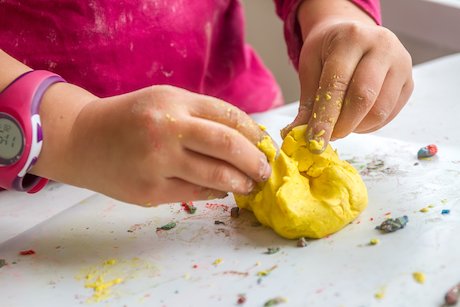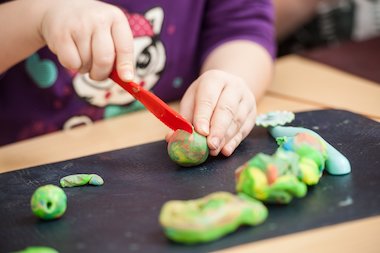What’s in your… malleable materials area?
Add to My Folder
In this series, Fe Luton explores the ways in which you can set up and run areas of continuous provision. Ideas for organisation, resources and planning are explored.

How should my malleable materials area be arranged?
Malleable materials cover all those things that can be manipulated into different shapes and sizes and changed by adding things like water. Malleable play promotes the exploration of mathematical concepts like shape and space, as well as scientific exploration of materials and their composition and behaviour under various conditions. Not only do these materials exploit the senses, but they are also amazing for developing fine motor skills through manipulation and the use of tools. There are also opportunities to develop descriptive and expressive language.
Consider the following when organising your malleable materials area:- Remember to offer malleable materials both on the floor and on tables as well as outside as this encourages children to interact with them in different ways
- Make sure that you know why you have out the materials that you have (other than that you always do) – this should be linked to observations and the needs of your cohort. If you consider hand strength, for example, you will need to reflect on how resistant the material you are using is – gloop requires a lot less resistance than clay or Plasticene®. Ensure that all adults know how to move children forward according to their specific learning needs
- Always ensure that you have checked for any health a safety issues surrounding materials or combinations of materials that you would like children to explore – think about inhaling, ingesting and touching. Any of these things could have huge implications for children with specific medical needs such as allergies or asthma. You will need very clear rules on how these materials are to be used and explored
- Remember that you are potentially covering a broad spectrum of the Early Years curriculum and that often, as a consequence, this can become an area that results in low level practice rather than high level learning

- Involve children in your decision making for this area. While tools will be readily available for them to select, the actual materials you are providing will be pre-selected, generally by you. To offer some level of ownership, children can feed back on materials that they particularly enjoy working with or investigations that have inspired them
What resources should I have in my malleable materials area?
Always make sure that children wear aprons when working with malleable materials. Encourage them to use a range of tools and their hands to interact with the materials available.
| Malleable materials | Tools | Resource enhancements |
|---|---|---|
| Rolled icing | Safe knives and forks | Sticks |
| Cornflour | Cooking utensils | Shells |
| Cooked pasta | Rolling pins | Empty packaging |
| Jelly | Cutters | Glitter |
| Gloop | Scissors | Jewels |
| Play dough | Objects for making imprints/ patterns | Coloured match sticks |
| Clay | Potato masher | Small world |
| Modroc | Garlic press | |
| Shaving foam | Wooden combs | |
| Cloud dough | ||
| Chocolate dough | ||
| Foam |
Scholastic Resource Bank: Early Years - join today!
- Over 2,000 EYFS resources, activity ideas and games
- Perfect for anyone working or playing with children from 0 to 5 years old
- Unlimited access from just £1.25 per month
Already a member? Sign in below.
Published 12 March 2018
Reviews
You need to be signed in to place a review.